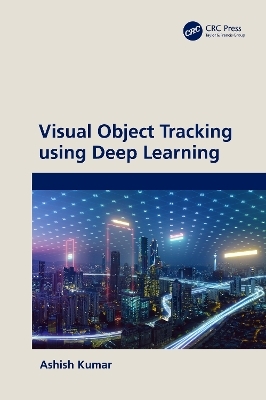
Visual Object Tracking using Deep Learning
CRC Press (Verlag)
978-1-032-49053-3 (ISBN)
This book covers the description of both conventional methods and advanced methods. In conventional methods, visual tracking techniques such as stochastic, deterministic, generative, and discriminative are discussed. The conventional techniques are further explored for multi-stage and collaborative frameworks. In advanced methods, various categories of deep learning-based trackers and correlation filter-based trackers are analyzed.
The book also:
Discusses potential performance metrics used for comparing the efficiency and effectiveness of various visual tracking methods
Elaborates on the salient features of deep learning trackers along with traditional trackers, wherein the handcrafted features are fused to reduce computational complexity
Illustrates various categories of correlation filter-based trackers suitable for superior and efficient performance under tedious tracking scenarios
Explores the future research directions for visual tracking by analyzing the real-time applications
The book comprehensively discusses various deep learning-based tracking architectures along with conventional tracking methods. It covers in-depth analysis of various feature extraction techniques, evaluation metrics and benchmark available for performance evaluation of tracking frameworks. The text is primarily written for senior undergraduates, graduate students, and academic researchers in the fields of electrical engineering, electronics and communication engineering, computer engineering, and information technology.
Dr. Ashish Kumar, Ph.D., is working as an assistant professor with Bennett University, Greater Noida, U.P., India. He has completed his Ph.D. in Computer Science and Engineering from Delhi Technological University (formerly DCE), New Delhi, India in 2020. He has received best researcher award from the Delhi Technological University for his contribution in the computer vision domain. He has completed M.Tech with distinction in computer Science and Engineering from GGS Inderpratha University, New Delhi. He has published many research papers in various reputed national and international journals and conferences. His current research interests include object tracking, image processing, artificial intelligence, and medical imaging analysis.
Chapter 1
Introduction to visual tracking in video sequences
1.1 Overview of visual tracking in video sequences
1.2 Motivation and challenges
1.3 Real-time applications of visual tracking
1.4 Emergence from the conventional to deep learning approaches
1.5 Performance evaluation criteria
1.6 Summary
Chapter 2
Background and research orientation for visual tracking appearance model: Standards and Models
2.1 Background and preliminaries
2.2 Conventional tracking methods
2.3 Deep learning-based methods
2.4 Correlation filter based visual trackers
2.5 Summary
Chapter 3
Target feature extraction for robust appearance model
3.1. Saliency feature extraction for visual tracking
3.2 Handcrafted features
3.3 Deep learning for feature extraction
3.4 Multi-feature fusion for efficient tracking
3.5 Summary
Chapter 4
Performance metrics for visual tracking: A Qualitative and Quantitative analysis
4.1 Introduction
4.2 Performance metrics for tracker evaluation
4.3 Performance metrics without ground truth
4.4 Performance metrics with ground truth
4.5 Summary
Chapter 5
Visual tracking datasets: Benchmark for Evaluation
5.1 Introduction
5.2 Problem with the self-generated datasets
5.3 Salient features of visual tracking public datasets
Chapter 6
Conventional framework for visual tracking: Challenges and solutions
6.1 Introduction
6.2 Deterministic tracking approach
6.2.1 Meanshift and its variant-based trackers
6.2.2 Multi-modal deterministic approach
6.3 Generative tracking approach
6.4 Discriminative tracking approach
6.5 Summary
Chapter 7
Stochastic framework for visual tracking: Challenges and Solutions
7.1 Introduction
7.2 Particle filter for visual tracking
7.3 Framework and procedure
7.4 Fusion of multi-feature and State estimation
7.5 Experimental Validation of the particle filter based tracker
7.6 Discussion on PF-variants based tracking
7.7 Summary
Chapter 8
Multi-stage and collaborative framework for visual tracking
8.1 Introduction
8.2 Multi-stage tracking algorithms
8.3 Framework and procedures
8.4 Collaborative tracking algorithms
8.5 Summary
Chapter 9
Deep learning based visual tracking model: A paradigm shift
9.1 Introduction
9.2 Deep learning-based tracking framework
9.3 Hyper-feature based deep learning networks
9.4 Multi-modal based deep learning trackers
9.5 Summary
Chapter 10
Correlation filter-based visual tracking model: Emergence and upgradation
10.1 Introduction
10.2 Correlation filter-based tracking framework
10.3 Deep Correlation Filter based trackers
10.4 Fusion-based correlation filter trackers
10.5 Discussion on correlation filter-based trackers
10.6 Summary
Chapter 11
Future prospects of visual tracking: Application Specific Analysis
11.1 Introduction
11.2 Pruning for deep neural architecture
11.3 Explainable AI
11.4 Application-specific visual tracking
11.6 Summary
Chapter 12
Deep learning-based multi-object tracking: Advancement for intelligent video analysis
12.1 Introduction
12.2 Multi-object tracking algorithms
12.3 Evaluation metrics for performance analysis
12.4 Benchmark for performance evaluation
12.5 Application of MOT algorithms
12.6 Limitations of existing MOT algorithms
12.7 Summary
| Erscheinungsdatum | 22.11.2023 |
|---|---|
| Zusatzinfo | 31 Tables, black and white; 10 Line drawings, black and white; 9 Halftones, black and white; 15 Illustrations, color; 4 Illustrations, black and white |
| Verlagsort | London |
| Sprache | englisch |
| Maße | 156 x 234 mm |
| Gewicht | 449 g |
| Themenwelt | Informatik ► Grafik / Design ► Digitale Bildverarbeitung |
| Informatik ► Theorie / Studium ► Künstliche Intelligenz / Robotik | |
| Technik ► Elektrotechnik / Energietechnik | |
| Technik ► Umwelttechnik / Biotechnologie | |
| ISBN-10 | 1-032-49053-5 / 1032490535 |
| ISBN-13 | 978-1-032-49053-3 / 9781032490533 |
| Zustand | Neuware |
| Haben Sie eine Frage zum Produkt? |
aus dem Bereich


